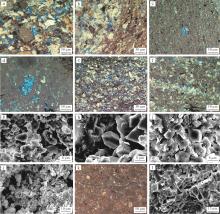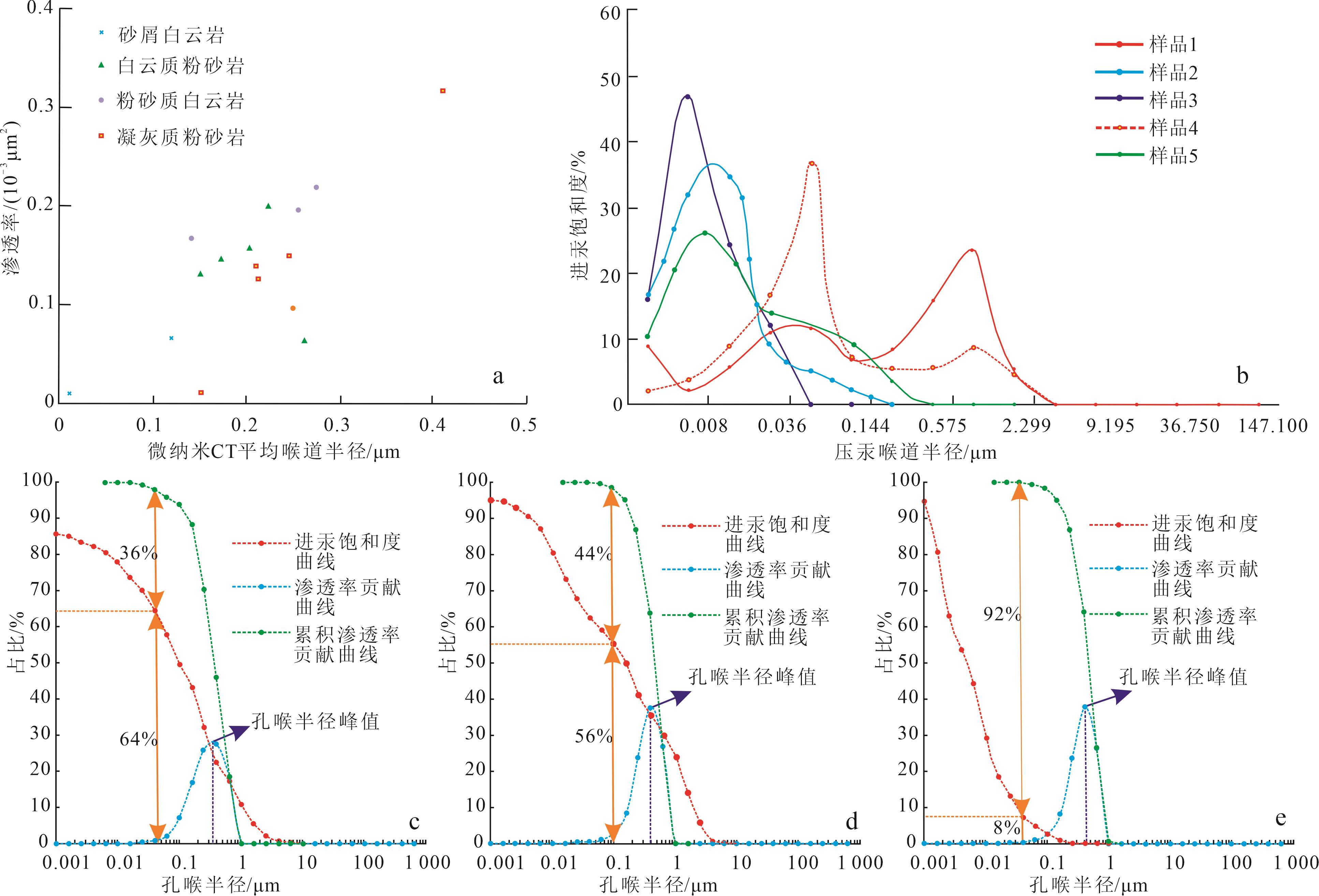

石油与天然气地质 ›› 2022, Vol. 43 ›› Issue (5): 1194-1205.doi: 10.11743/ogg20220515
马克1,2( ), 侯加根1(
), 侯加根1( ), 董虎2, 吴国强2, 闫林3, 张丽薇2
), 董虎2, 吴国强2, 闫林3, 张丽薇2
收稿日期:2021-12-29
修回日期:2022-07-12
出版日期:2022-10-01
发布日期:2022-09-02
通讯作者:
侯加根
E-mail:k.ma@irocktech.com;houjg63@cup.edu.cn
第一作者简介:马克(1988—),男,博士、工程师,油气田开发地质。E?mail: 基金项目:
Ke Ma1,2( ), Jiagen Hou1(
), Jiagen Hou1( ), Hu Dong2, Guoqiang Wu2, Lin Yan3, Liwei Zhang2
), Hu Dong2, Guoqiang Wu2, Lin Yan3, Liwei Zhang2
Received:2021-12-29
Revised:2022-07-12
Online:2022-10-01
Published:2022-09-02
Contact:
Jiagen Hou
E-mail:k.ma@irocktech.com;houjg63@cup.edu.cn
摘要:
准噶尔盆地吉木萨尔凹陷二叠系芦草沟组页岩油勘探近年来取得重大突破,使得这套储层成为陆相页岩油勘探开发的重要目标。综合运用铸体薄片、微量元素、扫描电镜、微米CT、纳米CT及多种压汞实验数据,研究了芦草沟组咸化湖混合细粒沉积复杂岩性内部孔喉结构及其对储层物性的影响。研究结果表明:芦草沟组白云质粉砂岩、粉砂质白云岩及砂屑白云岩构成了甜点体的优势岩性,微纳米级孔喉系统占据了储集空间主体,孔喉半径在数百微米至数十纳米的区间内连续分布;微米至亚微米级喉道对渗透率贡献最大,主流喉道半径区间为0.25~0.63 μm。微纳米级孔喉结构控制了储层的渗透性及含油性,优势岩性峰值孔喉半径大、分布范围宽,喉道半径分布区间、主流喉道半径及有效喉道体积是控制储层渗透率的关键因素。这些认识为储层油气充注预测及优势沉积相带内井位部署提供了重要的地质支撑。
中图分类号:
表1
吉木萨尔凹陷芦草沟组主要岩性典型样品物性及压汞参数统计"
| 地层 | 岩性 | 样品号 | 孔隙度/% | 渗透率/(10-3μm2) | 主要矿物含量/% | 最大连通孔喉 半径/μm | 中值半径/ μm | 排驱压力/ MPa | 退汞效率/ % | |
|---|---|---|---|---|---|---|---|---|---|---|
| 白云石 | 石英+长石 | |||||||||
上甜 点体 | 白云质粉砂岩 | DS-1 | 17.4 | 1.100 | 23.7 | 62.5 | 0.519 | 0.112 | 1.323 | 30.190 |
| DS-2 | 6.9 | 0.015 | 18.9 | 74.8 | 0.233 | 0.077 | 3.822 | 22.003 | ||
| 粉砂质白云岩 | SD-1 | 15.1 | 0.113 | 71.3 | 17.6 | 0.870 | 0.106 | 2.104 | 27.148 | |
| SD-2 | 12.7 | 0.023 | 65.8 | 22.1 | 0.359 | 0.063 | 2.566 | 25.332 | ||
| 砂屑白云岩 | D-1 | 7.1 | 0.017 | 89.6 | 7.8 | 0.753 | 0.055 | 3.771 | 22.969 | |
下甜 点体 | 白云质粉砂岩 | DS-3 | 8.3 | 0.011 | 16.5 | 67.7 | 0.464 | 0.071 | 3.655 | 23.010 |
| DS-4 | 4.1 | 0.008 | 26.9 | 62.8 | 0.257 | 0.051 | 4.126 | 20.202 | ||

图3
吉木萨尔凹陷芦草沟组白云质粉砂岩、粉砂质白云岩和砂屑白云岩的高压压汞及恒速压汞曲线分布特征a.3种岩性的高压压汞曲线,白云质粉砂岩,吉251井,3 609.67m, 粉砂质白云岩,吉174井,埋深3 128.81m, 砂屑白云岩,吉174井,埋深3 121.77m; b.白云质粉砂岩恒速压汞曲线,吉31井,埋深2 846.29 m,孔隙度12.28 %,渗透率0.060 × 10-3 μm2;c.粉砂质白云岩恒速压汞曲线,吉31井,埋深2 724.16 m,孔隙度6.59 %,渗透率26.269×10-3 μm2; d.砂屑白云岩恒速压汞曲线,吉251井,埋深3 618.88 m,孔隙度8.50 %,渗透率0.074 × 10-3 μm2"


图4
吉木萨尔凹陷芦草沟组页岩油储层孔隙类型微观照片a.白云质粉砂岩,吉174井,埋深3 143.30 m,溶蚀孔及残余粒间孔,铸体薄片; b.白云质粉砂岩突变为粉砂质白云岩,吉174井,埋深3 143.82 m,铸体薄片; c.粉砂质白云岩,吉174井,埋深3 121.68 m,晶间孔与溶蚀孔,铸体薄片; d.粉砂质泥晶云岩,吉174井,埋深3 149.46 m,颗粒溶蚀孔,铸体薄片; e.粉砂质白云岩,吉174井,埋深3 276.61 m,粒间孔与溶蚀孔,铸体薄片; f.白云质粉砂岩,吉174井,埋深3 282.14 m,粒间孔与溶蚀孔,铸体薄片; g.白云质粉砂岩,吉174井,埋深3 139.70 m,泥-粉晶白云石颗粒间溶蚀孔隙,扫描电镜; h.白云质粉砂岩,吉174井,埋深3 161.75 m,微米级粒间孔与溶蚀孔构成孔喉系统,扫描电镜,放大倍数×1 950; i.泥晶白云岩,吉174井,埋深3 177.42 m,微米级白云石颗粒晶间孔发育,扫描电镜; j.粉砂质白云岩,吉31井,埋深2 725.54 m,残余粒间孔与颗粒间溶蚀孔构成复合孔,扫描电镜; k.粉砂质白云岩,吉251井,埋深3 598.22 m,未被充填微裂缝,铸体薄片; l.粉砂质白云岩,吉174井,埋深3 146.54 m,白云石微米级晶间微裂缝,扫描电镜"


图7
吉木萨尔凹陷芦草沟组孔喉结构与储层物性关系a.纳米CT平均喉道半径与渗透率交会图; b.不同岩性样品喉道分布,样品1白云质粉砂岩,孔隙度为17.400 %,渗透率为1.100 × 10-3 μm2,样品2白云质粉砂岩,孔隙度为6.900 %,渗透率为0.015 × 10-3 μm2,样品3白云质粉砂岩,孔隙度4.100 %,渗透率小于0.010 × 10-3 μm2,样品4粉砂质白云岩,孔隙度15.100 %,渗透率0.133×10-3μm2,样品5砂屑白云岩,孔隙度12.700 %,渗透率0.022×10-3μm2; c.白云质粉砂岩孔喉渗透率贡献曲线,吉37井,埋深2 843.65 m,孔隙度12.281 %,渗透率0.060 × 10-3 μm2; d.白云质粉砂岩孔喉渗透率贡献曲线,吉32井,埋深3 567.31 m,孔隙度12.600 %,渗透率0.168 × 10-3 μm2; e.粉砂质白云岩孔喉渗透率贡献曲线,吉31井,埋深2 896.65 m,孔隙度5.420 %,渗透率0.003 × 10-3 μm2"

| 1 | 匡立春, 唐勇, 雷德文, 等. 准噶尔盆地二叠系咸化湖相云质岩致密油形成条件与勘探潜力[J]. 石油勘探与开发, 2012, 39(6):657-667. |
| Kuang Lichun, Tang Yong, Lei Dewen, et al. Formation conditions and exploration potential of tight oil in the Permian saline lacustrine dolomitic rock, Junggar Basin, NW China[J]. Petroleum Exploration and Development, 2012, 39(6): 657-667. | |
| 2 | 黎茂稳,马晓潇,金之钧,等.中国海、陆相页岩层系岩相组合多样性与非常规油气勘探意义[J].石油与天然气地质,2022,43(1):1-25. |
| Li Maowen, Ma Xiaoxiao, Jin Zhijun,et al. Diversity in the lithofacies assemblages of marine and lacustrine shale strata and significance for unconventional petroleum exploration in China[J].Oil & Gas Geology,2022,43(1):1-25. | |
| 3 | 范柏江,晋月,师良,等.鄂尔多斯盆地中部三叠系延长组7段湖相页岩油勘探潜力[J].石油与天然气地质, 2021, 42(5):1078-1088. |
| Fan Bojiang, Jin Yue, Shi Liang, et al. Shale oil exploration potential in central Ordos Basin: A case study of Chang 7 lacustrine shale[J]. Oil & Gas Geology,2021,42(5):1078-1088. | |
| 4 | 邓长生,张毅,谢小飞,等 .鄂尔多斯盆地延长油气区延长组长7段陆相页岩含气性分析[J].石油地质与工程,2020,34(1):20-25. |
| Deng Changsheng, Zhang Yi, Xie Xiaofei,et al. Gas bearing analysis of continental shale of Chang 7 Member of Yanchang Formation in Yanchang oil & gas region of Ordos Basin[J]. Petroleum Geology & Engineering, 2020, 34(1): 20–25. | |
| 5 | 赵政璋, 杜金虎, 邹才能, 等. 大油气区地质勘探理论及意义[J].石油勘探与开发, 2011,38(5): 513-522. |
| Zhao Zhengzhang, Du Jinhu, Zou Caineng, et al .Geological exploration theory for large oil and gas provinces and its significance[J]. Petroleum Exploration and Development, 2011, 38(5): 513-522. | |
| 6 | 马中振, 戴国威, 盛晓峰, 等. 松辽盆地北部连续型致密砂岩油藏的认识及其地质意义[J].中国矿业大学学报, 2013, 42(2): 221-229. |
| Ma Zhongzhen, Dai Guowei, Sheng Xiaofeng,et al. Tight sand oil reservoir of continuous type in northern Songliao Basin and its geological significance[J]. Journal of China University of Minimg & Technology, 2013, 42(2): 221-229. | |
| 7 | 蔡振家,雷裕红,罗晓容,等.鄂尔多斯盆地东南部延长组7段页岩有机孔发育特征及其影响因素[J].石油与天然气地质,2020,41(2):367-379. |
| Cai Zhenjia, Lei Yuhong, Luo Xiaorong, et al. Characteristics and controlling factors of organic pores in the 7th member of Yanchang formation shale in the Southeastern Ordos Basin[J]. Oil & Gas Geology,2020,41(2):367-379. | |
| 8 | 王成云, 匡立春, 高岗, 等. 吉木萨尔凹陷芦草沟组泥质岩类生烃潜力差异性分析[J].沉积学报, 2014, 32(2):385-390. |
| Wang Chengyun, Kuang Lichun, Gao Gang, et al. Difference in hydrocarbon generation potential of the shaly source rocks in Jimsar, Permian Lucaogou Formation[J].Acta Sedimentology Sinca, 2014, 32(2): 385-390. | |
| 9 | Joe H S, Quaker M, Adams A E .Maximizing information from fine‑grained sedimentary rocks: An inclusive nomenclature for mud‑stones[J].Journal of Sedimentary research,2003,73(5): 735-744. |
| 10 | 邹才能, 朱如凯, 白斌, 等 .致密油与页岩油内涵、特征、潜力及挑战[J].矿物岩石地球化学通报, 2015, 34(1): 1-17. |
| Zou Caineng, Zhu Rukai, Bai Bin, et al .Significance, geologic characteristics, resource potential and future challenges of tight oil and shale oil[J]. Bulletin of Mineralogy Petrology and Geochemistry, 2015, 34(1): 1-17. | |
| 11 | Loucks R G, Reed R M, Ruppel S C, et al. Spectrum of pore types and networks in mudrocks and a descriptive classification for matrix‑related mudrock pores[J].AAPG Bulletin, 2012, 96 (6): 1071-1098. |
| 12 | 马克, 侯加根, 刘钰铭, 等. 吉木萨尔凹陷二叠系芦草沟组咸化湖混合沉积模式[J].石油学报, 2017, 38(6): 636-648. |
| Ma Ke, Hou Jiagen, Liu Yuming,et al .The sedimentary model of saline lacustrine mixed sedimentation in Permian Lucaogou Formation,Jimsar Sag[J].Acta Petrolei Sinica, 2017, 38(6): 636-648. | |
| 13 | 葸克来, 操应长, 朱如凯, 等.吉木萨尔凹陷二叠系芦草沟组页岩油储层岩石类型及特征[J].石油学报, 2015, 36(12):1495-1507. |
| Xi Kelai, Cao Yingchang, Zhu Rukai, et al. Rock types and characteristics of tight oil reservoir in Permian Lucaogou Formation, Jimsar Sag[J]. Acta Petrolei Sinica, 2015, 36(12): 1495-1507. | |
| 14 | 王林生,叶义平,覃建华, 等. 陆相页岩油储层微观孔喉结构表征与含油性分级评价——以准噶尔盆地吉木萨尔凹陷二叠系芦草沟组为例[J]. 石油与天然气地质, 2022, 43 (1): 149-160. |
| Wang Linsheng, Ye Yiping, Qin Jianhua, et al. Microscopic pore structure characterization and oil‑bearing property evaluation of lacustrine shale reservoir:A case study of the Permian Lucaogou Formation in Jimsar Sag,Junggar Basin[J]. Oil & Gas Geology, 2022, 43(1): 149-160. | |
| 15 | 马铨峥,杨胜来,杨龙,等. 准噶尔盆地吉木萨尔凹陷芦草沟组致密储层微观孔隙特征[J].大庆石油地质与开发,2020,39(6):13-20. |
| Ma Quanzheng, Yang Shenglai, Yang Long,et al. Characteristics of the micro‑pore in Lucaogou‑Formation tight reservoir of Jimsar Sag, Junggar Basin[J].Petroleum Geology & Oilfield Development in Daqing,2020,39(6):13-20. | |
| 16 | 许琳,常秋生,杨成克, 等. 吉木萨尔凹陷二叠系芦草沟组页岩油储层特征及含油性[J].石油与天然气地质, 2019, 40(3):535-549. |
| Xu Lin, Chang Qiusheng, Yang Chengke, et al. Characteristics and oil‑bearing capability of shale oil reservoir in the Permian Lucaogou Formation,Jimusaer Sag[J].Oil & Gas Geology, 2019, 40(3):535-549. | |
| 17 | 支东明,唐勇,杨智峰, 等. 准噶尔盆地吉木萨尔凹陷陆相页岩油地质特征与聚集机理[J].石油与天然气地质, 2019, 40(3):524-534. |
| Zhi Dongming, Tang Yong, Yang Zhifeng, et al. Geological characteristics and accumulation mechanism of continental shale oil in Jimusaer Sag,Junggar Basin[J]. Oil & Gas Geology, 2019, 40(3):524-534. | |
| 18 | 马克,刘钰铭,侯加根, 等. 陆相咸化湖混合沉积致密储集层致密化机理——以吉木萨尔凹陷二叠系芦草沟组为例[J]. 新疆石油地质, 2019, 40(3): 253-261. |
| Ma Ke, Liu Yuming, Hou Jiagen, et al. Densification mechanism of tight reservoirs from mixed sedimentation in saline lacustrine environment:A case study of Permian Lucaogou Formation, Jimsar Sag[J]. Xinjiang Petroleum Geology, 2019, 40(3): 253-261. | |
| 19 | 王淼, 宋国奇, 王学军, 等. 东营凹陷咸化湖相纹层状烃源岩初次生排烃流体特征[J].中国石油大学学报(自然科学版),2020,44(2):31-41. |
| Wang Miao, Song Guoqi, Wang Xuejun, et al. Fluid features during the initial stage of hydrocarbon generation and expulsion in salt‑water lacustrine laminated source rocks of Dongying Depression[J]. Journal of China University of Petroleum(Edition of Natural Science), 2020, 44(1): 31-41. | |
| 20 | 邱振, 施振生, 董大忠, 等. 致密油源储特征与聚集机理——以准噶尔盆地吉木萨尔凹陷二叠系芦草沟组为例[J]. 石油勘探与开发, 2016, 43(6): 928-939. |
| Qiu Zhen, Shi Zhensheng, Dong Dazhong, et al. Geological characteristics of source rock and reservoir of tight oil and its accumulation mechanism: A case study of Permian Lucaogou Formation in Jimusar Sag, Junggar Basin[J]. Petroleum Exploration and Development, 2016, 43(6): 928-939. | |
| 21 | 刘惠民,杨怀宇,张鹏飞,等.古湖泊水介质条件对混积岩相组合沉积的控制作用——以渤海湾盆地东营凹陷古近系沙河街组三段为例[J].石油与天然气地质,2022,43(2):297-306. |
| Liu Huimin, Yang Huaiyu, Zhang Pengfei, et al. Control effect of paleolacustrine water conditions on mixed lithofacies assemblages:A case study of the Palaeogene Es 3, Dongying Sag, Bohai Bay Basin[J].Oil & Gas Geology,2022,43(2):297-306. | |
| 22 | 肖佃师,高阳,彭寿昌, 等. 准噶尔盆地吉木萨尔凹陷混积岩孔喉系统分类及控制因素[J]. 石油勘探与开发, 2021, 48 (4): 719-731. |
| Xiao Dianshi, Gao Yang, Peng Shouchang, et al. Classification and control factors of pore‑throat systems in hybrid sedimentary rocks of Jimusar Sag, Junggar Basin, NW China[J]. Petroleum Exploration and Development, 2021, 48(4): 719-731. | |
| 23 | 李长志,郭佩,柯先启 等.火山活动影响下的碱湖优质烃源岩成因及其对页岩油气勘探和开发的启示[J].石油与天然气地质,2021,42(6):1423-1434. |
| Li Changzhi, Guo Pei, Ke Xianqi, et al. Genesis of high‑quality source rocks in volcano‑related alkaline lakes and implications for the exploration and development of shale oil and gas[J]. Oil & Gas Geology,2021,42(6):1423-1434. | |
| 24 | 蒋宜勤, 柳益群, 杨召, 等. 准噶尔盆地吉木萨尔凹陷凝灰岩型页岩油特征与成因[J].石油勘探与开发,2015,42(6):741-749. |
| Jiang Yiqin, Liu Yiqun, Yang Zhao, et al. Characteristics and origin of tuff‑type tight oil in Jimusar Depression, Junggar Basin, NW China[J].Petroleum Exploration and Development, 2015, 42(6):741-749. | |
| 25 | 王剑,袁波,刘金,等. 准噶尔盆地吉木萨尔凹陷二叠系芦草沟组混积岩成因及其孔隙发育特征[J].石油实验地质,2022,44(3):413-424. |
| Wang Jian, Yuan Bo, Liu Jin,et al. Genesis and pore development characteristics of Permian Lucaogou Migmatites,Jimsar Sag,Junggar Basin[J].Petroleum Geology & Experiment, 2022,44(3):413-424. | |
| 26 | 黎茂稳,马晓潇,蒋启贵,等. 北美海相页岩油形成条件、富集特征与启示[J].油气地质与采收率,2019,26(1):13-28. |
| Li Maowen, Ma Xiaoxiao, Jiang Qigui,et al. Enlightenment from formation conditions and enrichment characteristics of marine shale oil in North America[J].Petroleum Geology and Recovery Efficiency, 2019,26(1):13-28. | |
| 27 | 刘金,王剑,张晓刚, 等. 准噶尔盆地吉木萨尔凹陷芦草沟组甜点页岩油微观赋存特征及成因机制[J].地质论评,2022,68(3):907-920. |
| Liu Jin, Wang Jian, Zhang Xiaogang,et al. Microscopic occurrence characteristics and genetic mechanism of shale oil in sweet spot reservoir of the Lucaogou Formation in Jimsar Sag[J].Geological Review, 2022,68(3):907-920. | |
| 28 | 彭寿昌,查小军,雷祥辉,等.吉木萨尔凹陷芦草沟组上“甜点”段页岩油储层演化特征及差异性评价[J].特种油气藏,2021,28(4):30-38. |
| Peng Shouchang, Zha Xiaojun, Lei Xianghui, et al. Evolution characteristics and difference evaluation of shale oil reservoirs in the upper sweet spot interval of Lucaogou Formation in Jimusaer Sag[J].Special Oil & Gas Reservoirs,2021,28(4):30-38. | |
| 29 | 董岩,徐东升,钱根葆,等.吉木萨尔页岩油“甜点”预测方法[J].特种油气藏,2020,27(3):54-59. |
| Dong Yan, Xu Dongsheng, Qian Genbao. Shale oil“sweet‑spot”prediction in Jimusar Sag[J]. Specail Oil & Gas Reservoirs, 2020,27(3):54-59. | |
| 30 | 慕尚超,郭小波,李钰,等. 三塘湖盆地马朗凹陷芦草沟组泥页岩储层孔隙结构及含油性[J].西安石油大学学报(自然科学版),2021,36(5):1-12. |
| Mu Shangchao, Guo Xiaobo, Li Yu, et al. Pore structure and oil-bearing properties of mud shale reservoirs of Lucaogou Formation in Malang Sag,Santanghu Basin[J].Journal of Xi'an Shiyou University(Natural Science Edition), 2021,36(5):1-12. | |
| 31 | 王圣柱. 博格达山山前带芦草沟组不同岩相储集特征及含油性[J].新疆石油地质,2020,41(4):402-413. |
| Wang Shengzhu. Reservoir characteristics and oil‑bearing properties of different lithofacies of Lucaogou Formation in the piedmont belt of Bogda Mountain[J].Xinjiang Petroleum Geology,2020,41(4):402-413. |
| [1] | 杜晓宇, 金之钧, 曾联波, 刘国平, 杨森, 梁新平, 陆国青. 基于成像测井的深层陆相页岩油储层天然裂缝有效性评价[J]. 石油与天然气地质, 2024, 45(3): 852-865. |
| [2] | 赵喆, 白斌, 刘畅, 王岚, 周海燕, 刘羽汐. 中国石油陆上中-高成熟度页岩油勘探现状、进展与未来思考[J]. 石油与天然气地质, 2024, 45(2): 327-340. |
| [3] | 潘虹, 于庆森, 李晓山, 宋俊强, 蒋志斌, 王丽, 罗官幸, 徐文秀, 尤浩宇. 准噶尔盆地红车断裂带石炭系重新认识及油气成藏特征[J]. 石油与天然气地质, 2024, 45(1): 215-230. |
| [4] | 郭旭升, 马晓潇, 黎茂稳, 钱门辉, 胡宗全. 陆相页岩油富集机理探讨[J]. 石油与天然气地质, 2023, 44(6): 1333-1349. |
| [5] | 李明, 王民, 张金友, 张宇辰, 刘召, 雒斌, 卞从胜, 李进步, 王鑫, 赵信斌, 董尚德. 中国典型盆地陆相页岩油组分评价及意义[J]. 石油与天然气地质, 2023, 44(6): 1479-1498. |
| [6] | 陈轩, 陶鑫, 覃建华, 许长福, 李映艳, 邓远, 高阳, 尹太举. 准噶尔盆地吉木萨尔凹陷及周缘二叠系芦草沟组异重流沉积[J]. 石油与天然气地质, 2023, 44(6): 1530-1545. |
| [7] | 刘惠民, 张关龙, 范婕, 曾治平, 郭瑞超, 宫亚军. 准噶尔盆地腹部征沙村地区征10井的勘探发现与启示[J]. 石油与天然气地质, 2023, 44(5): 1118-1128. |
| [8] | 赵耀, 潘虹, 骆飞飞, 李亮, 李丹杨, 谢宗瑞, 卢东连, 张琴. 准噶尔盆地红车断裂带石炭系火山岩储层特征及质量控制因素[J]. 石油与天然气地质, 2023, 44(5): 1129-1140. |
| [9] | 金之钧, 张谦, 朱如凯, 董琳, 付金华, 刘惠民, 云露, 刘国勇, 黎茂稳, 赵贤正, 王小军, 胡素云, 唐勇, 白振瑞, 孙冬胜, 李晓光. 中国陆相页岩油分类及其意义[J]. 石油与天然气地质, 2023, 44(4): 801-819. |
| [10] | 王宏博, 马存飞, 曹铮, 李志鹏, 韩长城, 纪文明, 杨艺. 基于岩相的致密砂岩差异成岩作用及其储层物性响应[J]. 石油与天然气地质, 2023, 44(4): 976-992. |
| [11] | 周家全, 王越, 宋子怡, 柳季廷, 成赛男. 准噶尔盆地博格达地区中二叠统芦草沟组热液硅质结核特征及页岩油意义[J]. 石油与天然气地质, 2023, 44(3): 789-800. |
| [12] | 孙靖, 尤新才, 薛晶晶, 曹元婷, 常秋生, 陈超. 准噶尔盆地异常压力特征及其对深层-超深层致密储层的影响[J]. 石油与天然气地质, 2023, 44(2): 350-365. |
| [13] | 李建忠, 王小军, 杨帆, 宋永, 阿布力米提·依明null, 卞保力, 刘海磊, 王学勇, 龚德瑜. 准噶尔盆地中央坳陷西部下组合油气成藏模式及勘探前景[J]. 石油与天然气地质, 2022, 43(5): 1059-1072. |
| [14] | 印森林, 陈恭洋, 许长福, 熊先钺, 赵军, 胡可. 陆相混积细粒储集岩岩相构型及其对甜点的控制作用[J]. 石油与天然气地质, 2022, 43(5): 1180-1193. |
| [15] | 郑国伟, 高之业, 黄立良, 姜振学, 何文军, 常佳琦, 段龙飞, 魏维航, 王志伟. 准噶尔盆地玛湖凹陷二叠系风城组页岩储层润湿性及其主控因素[J]. 石油与天然气地质, 2022, 43(5): 1206-1220. |
| 阅读次数 | ||||||||||||||||||||||||||||||||||||||||||||||||||
|
全文 171
|
|
|||||||||||||||||||||||||||||||||||||||||||||||||
|
摘要 288
|
|
|||||||||||||||||||||||||||||||||||||||||||||||||